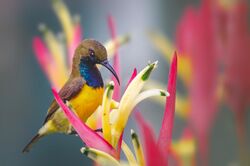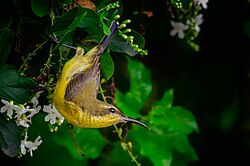Biology:Olive-backed sunbird
| Olive-backed sunbird | |
|---|---|

| |

| |
| Adult male and female, Philippines | |
| Scientific classification | |
| Domain: | Eukaryota |
| Kingdom: | Animalia |
| Phylum: | Chordata |
| Class: | Aves |
| Order: | Passeriformes |
| Family: | Nectariniidae |
| Genus: | Cinnyris |
| Species: | C. jugularis
|
| Binomial name | |
| Cinnyris jugularis (Linnaeus, 1766)
| |
| Synonyms | |
| |
The olive-backed sunbird (Cinnyris jugularis), also known as the garden sunbird, is a species of sunbird endemic to the Philippines except the Palawan island group.
Taxonomy
In 1760 the French zoologist Mathurin Jacques Brisson included a description of the olive-backed sunbird in his Ornithologie based on a specimen collected in the Philippines. He used the French name Le petit grimpereau des Philippines and the Latin Certhia Philippensis Minor.[2] Although Brisson coined Latin names, these do not conform to the binomial system and are not recognised by the International Commission on Zoological Nomenclature.[3] When in 1766 the Swedish naturalist Carl Linnaeus updated his Systema Naturae for the twelfth edition, he added 240 species that had been previously described by Brisson.[3] One of these was the olive-backed sunbird. Linnaeus included a brief description, coined the binomial name Certhia jugularis and cited Brisson's work.[4] The specific name jugularis is Medieval Latin for 'of the throat'.[5] This species is now placed in the genus Cinnyris that was introduced by the French naturalist Georges Cuvier in 1816.[6] It has 3 subspecies:[7] C. j. jugularis, C. j. obscurior, and C. j. woodi. For a long time, it has been formerly known as and conspecific with Olive-backed Sunbird and six other Cinnyris species.[8]
Description
They are small songbirds, 10–11.4 cm; male 6.7–11.9 g, female 6–10 g.[7] The male in its nominate (jugularis) form displays an olive hue on its upper body, featuring black wing feathers with green edges and a black tail adorned with white tips. The areas around its eyes (lores), neck, chin, throat, and breast are dark and iridescent, accompanied by yellow pectoral tufts. The lower portion of the bird is dark yellow, sometimes with a brown band encircling the gorget area. The iris is dark brown, while its bill and legs are black. Non-breeding males often have the glossy black coloration limited to the central throat stripe, which may represent juvenile birds transitioning to their adult plumage.
In contrast, the female exhibits an upper body of greenish olive, featuring a pale-yellowish stripe above the eyes (supercilium), yellowish borders on its wing feathers, a tail with black and white markings, and a deep yellow color on the lower portion of its body, slightly lighter on the undertail feathers. Juvenile birds resemble the female but tend to be paler and browner in appearance.
Distribution and habitat
The olive-backed sunbird is endemic to the Philippines where it is found throughout the country except Palawan. Subspecies obscurior is found in Northern Philippines (northern Luzon) while woodi is found in Sulu Archipelago, Southern Philippines. The nominate subspecies is found in the rest of the range of the bird. Originally from mangrove habitat, the olive-backed sunbird has adapted well to humans, and is now common even in fairly densely populated areas, even forming their nests in human dwellings.[9][10]
Behaviour and ecology
Breeding
Documented laying in May and June. Nest is built entirely by the female. The nest takes the form of a hanging oval pouch with a sheltered side opening, often featuring a dangling "beard." It is skillfully crafted using materials such as grass, cotton, moss, lichens, leaf fragments, vegetable fibers, and spider webs, lined with bark or feathers.[7]
Feeding
The sunbirds are a group of very small Old World passerine birds which feed largely on nectar, although they will also take insects, especially when feeding young. Their flight is fast and direct on their short wings. Most species can take nectar by hovering, but usually perch to feed most of the time.[citation needed]
References
- ↑ BirdLife International (2016). "Cinnyris jugularis". IUCN Red List of Threatened Species 2016: e.T103804139A94552679. doi:10.2305/IUCN.UK.2016-3.RLTS.T103804139A94552679.en. https://www.iucnredlist.org/species/103804139/94552679. Retrieved 12 November 2021.
- ↑ Brisson, Mathurin Jacques (1760) (in fr, la). Ornithologie, ou, Méthode contenant la division des oiseaux en ordres, sections, genres, especes & leurs variétés. 3. Paris: Jean-Baptiste Bauche. pp. 616–618, Plate 32 fig 5. https://biodiversitylibrary.org/page/35953719. The two stars (**) at the start of the section indicates that Brisson based his description on the examination of a specimen.
- ↑ 3.0 3.1 Allen, J.A. (1910). "Collation of Brisson's genera of birds with those of Linnaeus". Bulletin of the American Museum of Natural History 28: 317–335.
- ↑ Linnaeus, Carl (1766) (in la). Systema naturae : per regna tria natura, secundum classes, ordines, genera, species, cum characteribus, differentiis, synonymis, locis, Volume 1, Part 1. 12 (12th ed.). Holmiae (Stockholm): Laurentii Salvii. p. 245. https://biodiversitylibrary.org/page/14482362.
- ↑ Jobling, J.A. (2018). "Key to Scientific Names in Ornithology". in del Hoyo, J.; Elliott, A.; Sargatal, J. et al.. Handbook of the Birds of the World Alive. Lynx Edicions. https://www.hbw.com/dictionary/definition/jugularis.
- ↑ Cuvier, Georges (1816) (in fr). Le Règne animal distribué d'après son organisation : pour servir de base a l'histoire naturelle des animaux et d'introduction a l'anatomie comparée. 1. Paris: Déterville. pp. 388–389. https://biodiversitylibrary.org/page/1844898.
- ↑ 7.0 7.1 7.2 Cheke, Robert; Mann, Clive; Kirwan, Guy M.; Christie, David (2023). "Garden Sunbird (Cinnyris jugularis), version 1.0" (in en). Birds of the World. doi:10.2173/bow.olbsun31.01species_shared.bow.project_name. ISSN 2771-3105. https://birdsoftheworld.org/bow/species/olbsun31/cur/introduction.
- ↑ "2023 eBird Taxonomy Update - eBird Science". https://science.ebird.org/en/use-ebird-data/the-ebird-taxonomy/2023-ebird-taxonomy-update#splits.
- ↑ Olive-backed Sunbird
- ↑ Sunbird letters
External links
Wikidata ☰ Q766717 entry
 |



